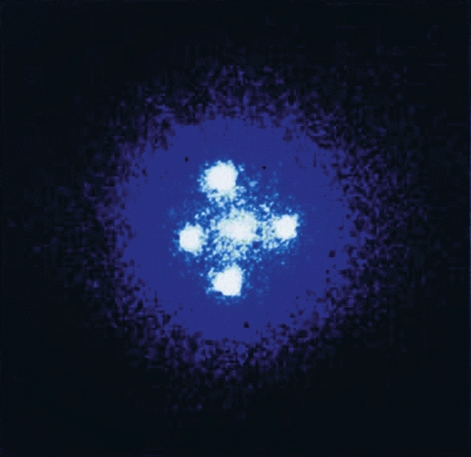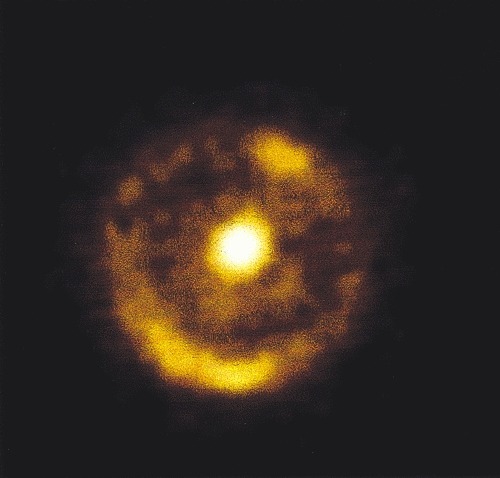General Relativity
Theory of General Relativity
- Einstein presented his theory of general relativity in 1915 and it is based
on the idea that space and time are linked. We call this the fabric of spacetime.
From the name fabric, we infer that spacetime can be bent in any direction. Thus,
space can be curved.
- There are a few basic consequences of general relativity (GR):
- Gravity is a distortion of spacetime - It is not a force that we learned.
- Time runs slower in a gravitational field.
- The universe has no boundaries and therefore has no center.
- Masses emit gravitational waves.
- One of the most important aspects of GR is the EQUIVALENCE PRINCIPLE. Einstein calls
this the happiest thought of his life.
- The equivalence principle states "The effects of gravity are exactly equivalent to
the effects of acceleration".
- This implies that we cannot tell the difference if we were in a gravitational field
or accelerating. The laws of physics, and hence our perception of the world, is the
same whether we are sitting here on Earth or accelerating in a rocket through space.
- This realization alone had profound impacts and is the basis for GR.
- The shape of spacetime requires a new definition of a "straight line". The way to
define a straight line is that trajectory that is followed where object experience
weightlessness. Otherwise, if you experience weight, then you must be accelerating
(according to the equivalence principle) and, hence, you must be changing your direction
through spacetime.
- Since the space station feels weightlessness, then it is traveling in the straightest
possible path through spacetime. Similarly the Earth is going straight as it orbits
around the Sun. We standing here on the Earth are, however, accelerating.
- Gravitational Time Dilation tells us that time runs slower the closer you are to
a gravitational field. Thus, people who live a low elevations on Earth should live longer
than people at higher elevations. Thus, for an object falling into a black hole, from
the outside we would see their clock get slower and slower as it approached the
event horizon and eventually stop.
Observational Evidence for GR
- There are multiple observations now that support GR, but there were two historic
observations that convinced everyone. These are the precession of Mercury, and the
bending of light by the Sun or GRAVITATIONAL LENSING.
- It had been known for a very long time that the orbit of Mercury actually precesses.
It was thought for a long time that Mercury's orbit was off because of an
undiscovered planet (some people called this planet Vulcan). It was a big mystery
until Einstein explained it, and he calls this discovery the high point of
his scientific life.
- Mercury is on a elliptical orbit so sometimes it is closer to the Sun than other
times. In straight Newtonian physics, this would not matter and we should be able
to measure the orbital time accuractely. But according to GR, the closer to get to
a massive object, in this case the Sun, then both space and time are altered. Thus,
Mercury was going in and out of different spacetime geometries.
- In 1915, Einstein used GR is predict exactly the proper orbit of Mercury and explained
the discrepency.
- Einstein also predicted that light should be bent as it travels next to a massive object.
If spacetime is curved, then any particle, including massless ones like photons, will
have to obey the shape of space. This was unheard of before because we had assumed that
gravity only acts on particles with mass.
- So in 1919, Einstein predicted that if we observe stars close to the Sun during a
solar eclipse, those stars should appear in a different place since the light is
bent as it travels through the curved spacetime near the Sun. Einstein's calculation
was exact, and this observation gave him instant fame.
- This effect is called gravitational lensing (the massive object acts as a lens) and
we have now seen many effects from it. The images below show two astronomical
examples of it. The first is an Einstein Cross and the second is an Einstein Ring.


- Since spacetime can be curved, then sudden changes in a mass can cause ripples
through this spacetime. The effect is a gravitational wave. Two massive objects
that orbit each other are similar to an eggbeater in spacetime. They stir up the
shape of spacetime and send out a ripple. There are a few programs now that are
trying to detect these ripples. LIGO did it!
- Due to the curvature of spacetime, there are ways in which we can time travel and
travel distant parts in the universe in a short amount of time. Using the analogy of
Earth, if we want to travel of NYC to Hong Kong, the fastest way to go would be
to travel through the Earth, if we could.
- Similarly in the universe, if we could find a shortcut, we would be able to travel
to distant places without going in the straight line (and therefore not violated the
fact that nothing can travel faster than the speed of light). We call these shortcuts
wormholes.
- Wormholes may actually exists, but we do not have the physics or technology to explore
the question yet. However, there is a philosophical problem with there existence
since they would allow time travel. If we could travel in time, then we could back
in time and as soon as that happens, all sorts of paradoxes arise that you have seen
in many movies and science fiction novels. Thus, most scientists end up concluding that
it cannot happen.

